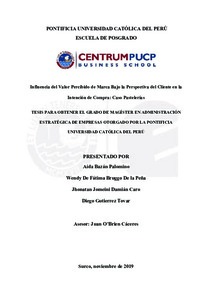Influencia del valor percibido de marca bajo la perspectiva del cliente en la intención de compra: caso pastelerías

View/
Date
2020-01-28Author
Bazán Palomino, Aída
Bruggo De la Peña, Wendy De Fátima
Damián Caro, Jhonatan Jomeini
Gutierrez Tovar, Diego
Metadata
Show full item recordAbstract
El objetivo principal de la presente investigación es conocer la influencia del valor
percibido de marca bajo la perspectiva del cliente en la intención de compra, basado en el
marco conceptual de los modelos seminales de Aaker y Keller, en el sector pastelería en la
provincia de Lima, Perú, en el periodo comprendido entre abril y julio del 2019.
La investigación se definió de tipo cuantitativa y no experimental, transversal,
descriptiva y correlacional-causal, dado que se plantea un problema y las hipótesis de la
investigación buscan determinar el grado en que las variables están asociadas (Hernández,
Fernández y Baptista, 2010). Para la recolección de datos se definió la muestra en base a
muestreo probabilístico por conglomerado, a través de una muestra bajo condiciones
definidas; y luego a través de muestreo no probabilístico por conveniencia se buscó llegar al
total de la muestra por su fácil acceso, para ello se empleó la encuesta electrónica, por la
ventaja de disponibilidad, flexibilidad geográfica y bajo costo (Zikmund y Babin, 2009). La
investigación ha considerado tres pastelerías: La Mora Pastelería & Café, San Antonio y
Dolce Capriccio, nominadas en el top 20 del ranking Summum Perú 2018, y permitió conocer
las variables del valor de marca que influyen en la intención de compra; asimismo, identificar
aquellas menos destacables para el sector de estudio con la finalidad de obtener información
relevante que sea útil para el planteamiento de estrategias de marketing que ayuden a generar
mayor rentabilidad y eficiencia en las organizaciones.
Los resultados permitieron conocer que la intención de compra de los clientes se
impacta por (a) la notoriedad de marca, que es la capacidad de identificar una marca sin la
necesidad de tener el producto al frente (Keller, 1993); (b) la calidad percibida, que es la
percepción que tiene un cliente acerca de la superioridad de un producto sobre otro (Aaker,
1991); y (c) el valor de marca en donde la asociación de lealtad (núcleo del brand equity,
Aaker 1991) e imagen hacia la marca, se conjugan como rasgos de fortaleza en el mercado. The main objective of the present investigation is to know the influence perceived of
brand equity from the perspective of the customer in the purchase intention, based on the
conceptual framework of the seminal models of Aaker and Keller, in the bakery sector in
Lima, Peru, between April and July 2019.
This research was defined as quantitative and non-experimental, transversal,
descriptive and correlational-causal, given that a problem arises and the research hypotheses
seek to determine the degree to which the variables are associated (Hernández, Fernández and
Baptista, 2010). For the data collection the sample was defined based on probabilistic
sampling by cluster, through a sample under defined conditions; and then through nonprobabilistic
sampling for convenience, the total sample was reached due to its easy access,
for this the electronic survey was used, for the advantage of availability, geographical
flexibility and low cost (Zikmund and Babin, 2009). The research has considered three
patisseries: La Mora Pastelería & Café, San Antonio and Dolce Capriccio, nominated in the
top 20 of the Summum Peru 2018 ranking, and allowed to know the variables of brand equity
that influence the purchase intention; Likewise, identify those that are less remarkable for the
study sector in order to obtain relevant information that is useful for planning marketing
strategies that help to generate greater profitability and efficiency in organizations.
The results allowed us to know that the intention of buying customers is impacted by
(a) brand awareness, which is the ability to identify a brand without the need to have a
product in front fo them (Keller, 1993); (b) the perceived quality, which is the perception that
a customer has about the superiority of one product over another (Aaker, 1991); and (c) the
brand equity in which the loyalty association (core of brand equity, Aaker 1991) and image
towards the brand, are combined as traits of strength in the market.
Temas
Investigación cuantitativa
Comportamiento del consumidor--Pastelerías--Perú
Comportamiento del consumidor--Pastelerías--Perú
Para optar el título de
Maestro en Administración Estratégica de Empresas
Collections
The following license files are associated with this item:





